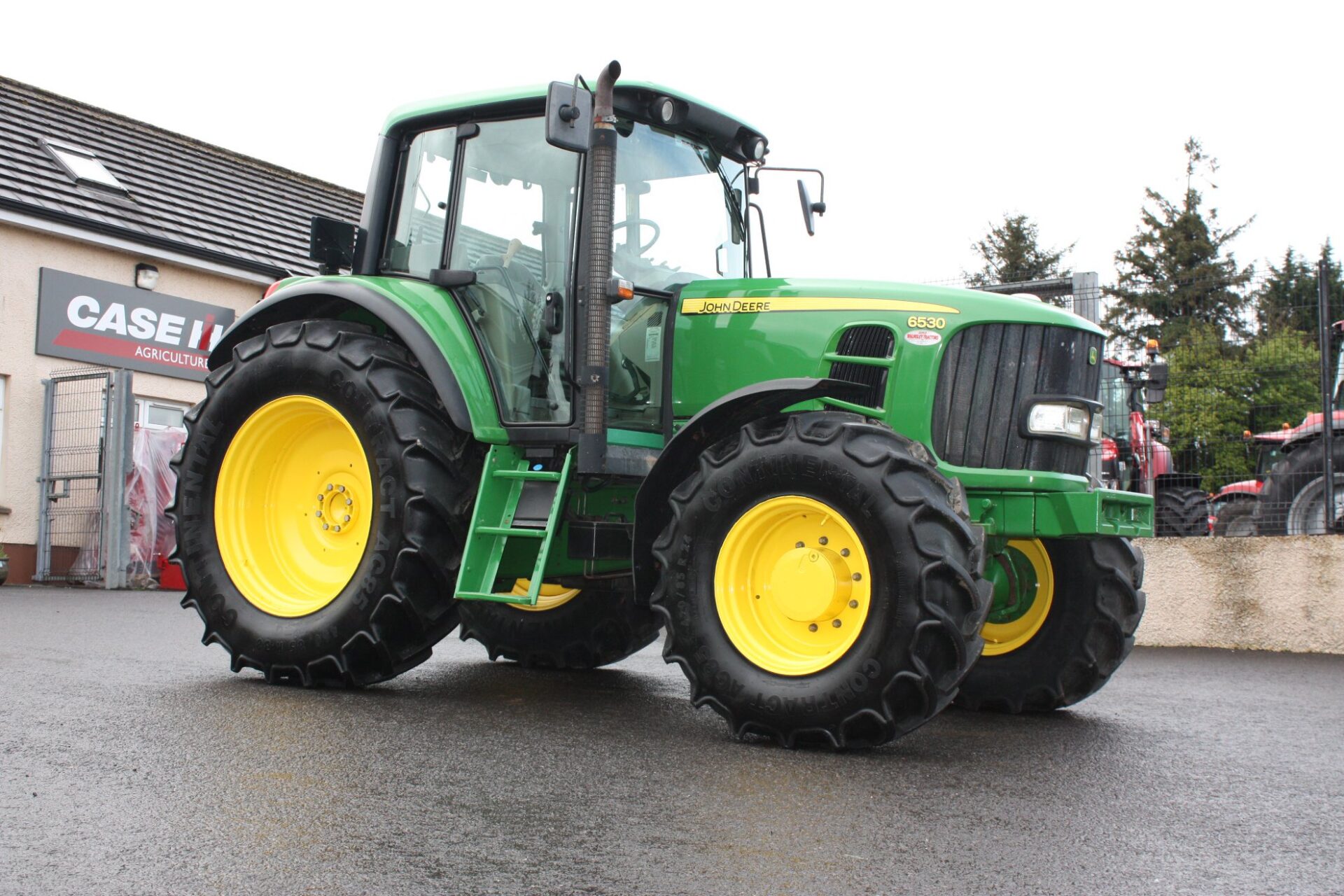The John Deere 6530 tractor, produced between 2006 and 2008, is a reliable and versatile agricultural workhorse known for its performance and durability. It was designed to cater to the needs of farmers and agricultural professionals, offering a range of transmission options and power capabilities. With its solid build quality and John Deere’s reputation for quality, the 6530 is a trusted companion in the field, capable of handling various farming tasks with ease. Its comfortable operator cabin and user-friendly controls make it a practical choice for long hours of operation. This model is a testament to John Deere’s commitment to providing efficient and dependable machinery for the agricultural industry.
| Production |
|---|
| Manufacturer | John Deere |
| Engine |
|---|
| Gross Engine Power | 120 hp (89.5 kW) |
| Net Engine Power | 115 hp (85.8 kW) |
| Maximum Engine Power | 126 hp (94.0 kW) |
| PTO (claimed) | 102 hp (76.1 kW) |
| Engine Detail |
|---|
| Model | John Deere 6068 HL280 |
| Cylinders | 6-cylinder 12-valve |
| Cooling | Liquid-cooled |
| Displacement | 413.7 ci (6.8 L) |
| Bore/Stroke | 4.19×5.00 inches (106 x 127 mm) |
| Emissions | Tier III |
| Rated Power (ECE R24) | 115 hp (85.8 kW) |
| Rated Power (EC 97/98) | 120 hp (89.5 kW) |
| Maximum Power (ECE R24) | 121 hp (90.2 kW) |
| Maximum Power (EC 97/68) | 126 hp (94.0 kW) |
| Fuel System | High-pressure common rail injection |
| Cooling System | Viscous fan |
| Air Cleaner | Dry element |
| Rated RPM | 2300 |
| Idle RPM | 850-2460 |
| Operating RPM | 1600-2300 |
| Torque | 358 lb-ft (485.4 Nm) at 1600 RPM |
| Firing Order | 1-5-3-6-2-4 |
| Starter Volts | 12 |
| Starter Power | 4 hp (3.0 kW) |
| Oil Capacity | 20.6 qts (19.5 L) |
| Coolant Capacity | 29.6 qts (28.0 L) |
| Intake Valve Clearance | 0.014 inches (0.356 mm) |
| Exhaust Valve Clearance | 0.018 inches (0.457 mm) |
| Mechanical |
|---|
| Chassis | Available in 4×2 2WD or 4×4 MFWD 4WD (optional) |
| Differential Lock | Rear electro-hydraulic wet disc |
| Brakes | Hydraulic wet disc |
| Cab | Two-post foldable Roll-Guard ROPS (Cab with air-conditioning optional) |
| Capacity |
|---|
| Fuel Capacity | 54.7 gal (207.0 L) or 66 gal (249.8 L)* |
| Hydraulic System Capacity | 13.2 gal (50.0 L) |
| Hydraulic System Type | Constant flow load sensing |
| Tractor Hitch | Rear Type II or II/IIIN* with load and depth control |
| Rear Lift Capacity | 11,470 lbs (5202 kg) or 13,260 lbs (6014 kg)* |
| Power Take-off (PTO) |
|---|
| Rear PTO | Independent |
| Clutch | Electro-hydraulic wet disc |
| Rear RPM | 540/540E/1000 |
| Engine RPM | 540@2143, 540E@1684, 1000@2208 |
| Front RPM | 1000 |
| Engine RPM | 1000@2185 |
| Standard Tires (Ag): |
|---|
| Front | 420/70R28 |
| Rear | 18.4R38 |
| Dimensions |
|---|
| Wheelbase | 104.3 inches (264 cm) |
| Length | 186.1 inches (472 cm) |
| Width | 91.2 inches (231 cm) |
| Height | 111.5 inches (283 cm) |
| Front Tread | 58.5 to 80.4 inches (148 to 204 cm) (2WD) |
| Front Tread | 63.9 to 83.3 inches (162 to 211 cm) (4WD) |
| Rear Tread | 63.9 to 79.6 inches (162 to 202 cm) |
| Weight |
|---|
| Shipping | 11,390 lbs (5166 kg) |
| Max Capacity | 18,740 lbs (8500 kg) |
| Max Rear Axle | 14,330 lbs (6500 kg) |
| Serial Numbers |
|---|
| Location | Front-right side of the main tractor frame, above the front axle. |
| Electrical |
|---|
| Ground | Negative |
| Charging System | Alternator |
| Charging Amps | 90 (Optional |
| Battery Volts | 12 |
John Deere 6530 Advantages:
Versatility: The John Deere 6530 offers multiple transmission options, making it adaptable for various farming tasks, from fieldwork to towing and more.
Reliability: Known for its robust build and John Deere’s reputation for quality, this tractor is reliable and durable, with a long service life.
Powerful Engine: The tractor boasts a powerful engine, providing ample horsepower for demanding agricultural applications.
Operator Comfort: The cabin is designed for operator comfort, with options for air-conditioning and user-friendly controls, reducing operator fatigue during long workdays.
Hydraulic System: The constant flow load sensing hydraulic system ensures efficient and precise control of hydraulic functions, enhancing productivity.
John Deere 6530 Disadvantages:
Age: As a model from 2006-2008, it may lack some of the advanced technology and features found in more recent tractor models.
Maintenance Costs: Older models may require more frequent maintenance and replacement of parts, potentially increasing operational costs.
Fuel Efficiency: The tractor’s engine may be less fuel-efficient compared to newer models, contributing to higher fuel expenses.
Limited Features: It may lack some of the advanced features, such as integrated precision agriculture technologies, that are available in modern tractors.
Resale Value: Older tractor models tend to have lower resale values compared to newer ones, which could impact the return on investment when it’s time to upgrade.
